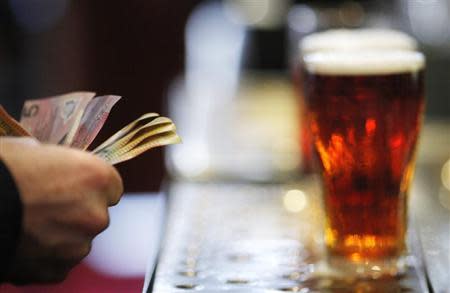Teenagers who drink have more friends: study
By Kathryn Doyle NEW YORK (Reuters Health) - Middle and high school students who drink alcohol are often the same ones winning the popularity contests, new research suggests. Previous studies have found friend groups can influence choices about alcohol, but haven't looked at the possible social payoffs of drinking. "There has not been much data to support that drinking among teenagers directly leads to higher popularity and more friendships," said Peter Delany. He is the director of the Substance Abuse and Mental Health Services Administration's (SAMHSA) Center for Behavioral Health Statistics and Quality in Rockville, Maryland. Delany was not part of the study team, which was led by Mir M. Ali, also from SAMHSA. "The fact remains that underage drinking is linked to a long list of adverse health and behavioral consequences, including the deaths of thousands of adolescents and young adults each year," Delany told Reuters Health in an email. Ali and colleagues analyzed data from a national study of 7th through 12th graders from 132 schools who were surveyed in 1994. The survey included a variety of questions on drinking and substance use, number of friends, friends of friends, home life and other factors. Teens who reported occasional drinking and getting drunk tended to have higher "social connectedness" than their abstaining peers. That was especially true for white students. Getting drunk seemed to be more important for popularity than just drinking in general. Kids who drank at all reported having an extra half a friend, on average, and those who got drunk reported one additional friend compared to non-drinkers. The findings "provide new evidence on the motivation behind adolescent drinking," the researchers wrote in the journal Addictive Behaviors. "There are many healthy behaviors, both athletic and academic, that increase teens' popularity among peers," Delany said. For instance, two of the study's authors found in an earlier paper, published in the Journal of Public Health, that playing sports leads to more friends for overweight white boys. Family, peers, schools and neighborhoods can all influence teen drinking and may also indirectly influence how much popularity teens gain by drinking, Delany said. "We know that parental influence can help adolescents resist drinking and other forms of substance use," he said. "Recent SAMHSA reports have shown that adolescents are very influenced by their parents' attitudes on substance use." Teens need adult help to develop a healthy relationship with alcohol and to have positive social values, Joseph P. Allen said. Allen studies adolescent social development at the University of Virginia in Charlottesville. He was not part of the new research. "Adults often avoid teens like the plague, but then we're surprised when, left to their own devices, they develop values with which we're not comfortable," Allen said. "If we don't engage with teens - by getting them involved in volunteer service, encouraging their participation in civic activities and debates and just talking to them - then we can't be too surprised when their values are largely those that appear in the online and popular media." The link between drinking and having friends is not only an issue for the underage, researchers noted. "One of the toughest problems with teen alcohol use is that alcohol use is associated with greater social involvement, and likely popularity, even in adulthood," Allen said. "Teens are often just trying to do what they see adults doing, and it's hard to convince them it's a terrible thing when they see both social and work-life events where alcohol plays a prominent role," he said. "Our best chance is likely to give teens ways to feel like they are moving into the adult world that don't revolve just around alcohol," he said. Parents can consult resources like SAMHSA's "Navigating the Teen Years: A Parent's Handbook for Raising Healthy Teens," Delany said. The handbook is available here: http://1.usa.gov/JHyeEC. SOURCE: http://bit.ly/19QUp7w Addictive Behaviors, online December 12, 2013.


